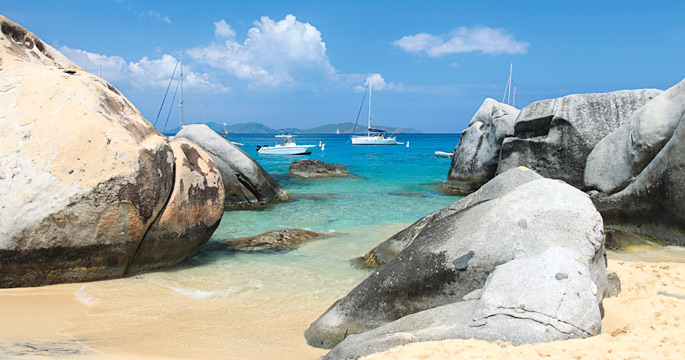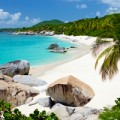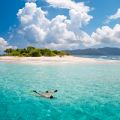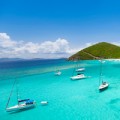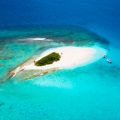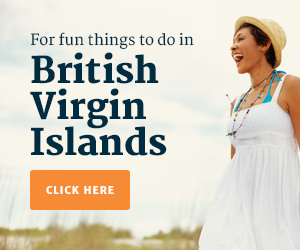With or without a crew, a charter boat can be a cost-effective and versatile way to cruise the islands.
Planning a vacation to the British Virgin Islands (BVI) is a bit like opening a box of chocolates. So many tempting choices that it’s hard to choose just one. Nightlife or seclusion? Luxury villa or beachfront cottage? Each island has something slightly different to offer. So why not try them all. Gorging might be a bad thing when it comes to sweets, but if you take to the sea, you can sample the best of the BVI, setting your own pace and itinerary as you harbor hop.
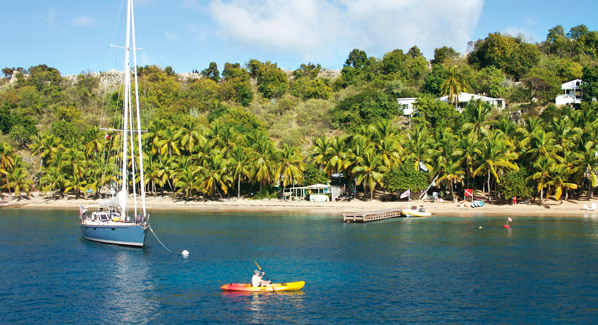
Stowing a kayak aboard allows you to tour the harbor when the big boat remains tied to the mooring. Photo: Pierce Hoover
Ideal Islands
There’s a reason why the British Virgin Islands are the world’s favorite charter-boat destination. The islands seem made for recreational sailing. They are within sight of each other and arranged roughly in a rectangle, with Drake’s Passage in the middle. Predictable trade winds blow in from the east, and there are sheltered harbors and coves on every island. This favorable geography allows cruisers to set zigzagging courses between islands, with crossings lasting hours rather than days. You can leave port late, stop for a bit of snorkeling and still arrive in the next port before happy hour.
Cost-Effective Cruising
Think charter yachts are only for the mega wealthy? Not true. Vessels-for- hire come in all shapes and sizes, from compact sloops to luxury yachts. When you add up the cost on a per-person basis, a boating vacation can compare favorable with a resort stay. At the lower end of the range, a 32-foot sailboat suitable for a couple or family of four can be chartered for $2,000 to $2,500 a week—though in reality you’ll want to add about half of that amount to cover provisions, moorage fees and other incidentals. At the other end of the spectrum, a 65-foot luxury catamaran with crew could command 10 times that sum. But when split between four couples, even that ultra-luxe option breaks down to less than $400 a day per person, and that includes water sports, top-shelf libations and onboard meals created by a personal chef.
Self-Guided or Self-Indulgent
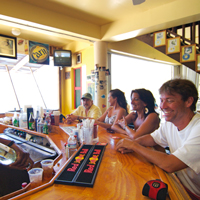
Midday libations at Tortolla’s Cane Garden Bay. Photo: Pierce Hoover
There are two primary types of charter offered in the British Virgins. A crewed charter is like a limo ride: You just sit back and let a professional do the work. A bareboat charter puts you in command—but only if are a competent sailor or powerboat operator capable of navigating around the islands and attending to the various details of shipboard life. As an in- between, many charter companies will add a captain to a bareboat charter for an additional fee. This gives novices a chance to learn the ropes without running afoul of the rocks.
One Hull or Two?
One of the first decisions you’ll make when choosing a charter boat is whether you want to go with a single-hull vessel or opt for a twin-hulled catamaran. Each has its merits. Serious sailors usually opt for a more traditional monohull, as they enjoy the sensation of a well-tuned craft heeling to leeward as the trade winds urge it forward. Catamarans usually offer a more gentile and upright passage. There’s more deck space on a cat and usually a more spacious central salon with large windows. Sleeping cabins on a cat may be slightly smaller in boats under 50 feet, as they sit in narrower hulls. Catamarans also tend to command a higher charter price as compared to a monohull of similar crew capacity.
Sail Away or Power Up?
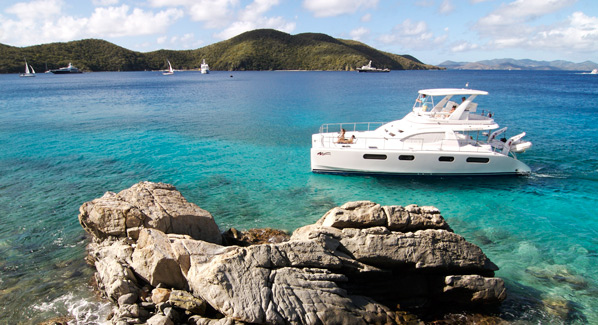
A power catamaran eliminates the work of sailing and allows cruisers to ply calm, lee-shore waters. Photo: Christian Wheatley / iStock
To a sailor, there are few things better than spending the day reaching and tacking about before discovering new ports of call. For those who tend to focus less on the journey and are more about the destination, there are powerboat charters. Motor boaters typically make faster crossings than their sailing brethren, and under power, it’s sometimes possible to plan routes along more sheltered lees shores to avoid wind and waves. But when you do hit a cross sea without the stabilizing effects of a sail, there may be more rolling and pitching. Fortunately, the power catamarans that prevail in the BVI rental fleets are less susceptible to motion than single-hull motorboats.
Anchors Away
Setting an anchor can be tricky, especially in a crowded harbor where dragging the hook or swinging into another boat could dampen a vacation cruise. In addition, the steady wear and tear of metal hooks and chains on fragile sea bottoms can wreck havoc on the underwater ecosystem. In the British Virgins, there’s an easier way to stop for the night. Mooring balls have been installed in most all of the major anchorages. All you need do is loop a bowline around one, pay a modest usage fee and relax, knowing there’s no danger of crashing into another boat or a lee shore.
Beat the Crowds
Setting your own cruising schedule allows you to visit all of the BVI’s most popular landfalls, including The Baths, Cane Garden Bay and White Sound. Even better, you can do it in a time frame that avoids the crowds that often descend on these sites when tour buses and shuttle boats arrive. Cane Garden may be congested midday, but come early or stay late and you will have it practically to yourself.
Travel Like Others Can’t
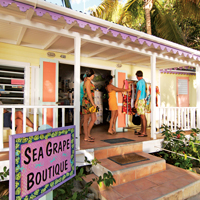
Local shopping excursion on Cooper Island. Photo: Pierce Hoover
Having your own aquatic means of transport opens up a whole realm of destinations that are difficult, or in some cases impossible, to reach by cruise ship, ferry or island taxi. It also allows you to pack more into your day. For example, you could cast off after breakfast in Cooper Island, beat the crowds to The Baths, tie up for lunch in Spanish Town, spend an afternoon snorkeling the Dogs, and then head to North Sound for dinner at the Bitter End.
Shore Leaves
One of the best parts of cruising the British Virgins is creating your own itinerary. That said, here are some of our favorite stops that should not be missed:
The Bight at Norma Island
Be sure to stop and snorkel the Indians on the way over, then arrive in time to snag a mooring ball in the sheltered eastern end of the bay. Take the dingy over to the cliffs that hide Bluebeard’s treasure cave, swim and swill on the beach at Pirate’s Bight, or leave your inhibitions behind and tie up to the Willie T., the harbor’s notorious floating tavern.
The Baths National Park
You’ve probably seen the pictures. Giant boulders strewn along a white-sand beach like a giant’s abandoned marbles. Come early and tie into one of the park’s day-use mooring buoys, and you’ll have the prime location for snorkeling and exploring the rock formations.
North Sound
The protected waters of Virgin Gorda’s North Sound are home to several great beachfront resorts and eateries. Tie in close to the Bitter End Yacht Club and spend the day beaching it at the Sandbox on Prickly Pear, snorkeling the front reefs or skimming the bay on a rented dinghy or windsurfer. Head to Saba Rock to cap off the evening.
White Bay
The most laid-back beach scene on Jost Van Dyke island is at White Bay. Whether it’s the ring game at the Soggy Dollar or the hammock at Ivan’s Stress-Free Bar, this is beach bumming at its best. Stay for the night and you can, as Jimmy Buffett once sang, “see the lights of St. Thomas 20 miles west.”
Anegada
If time and your charter contract allow, a trip to Anegada is a passage back in time. Low lying and sparely settled, this is the place to spend a day sunning and swimming on the east coast beach of Loblolly Bay before returning for one of the island’s famous barbecue lobster dinners.

